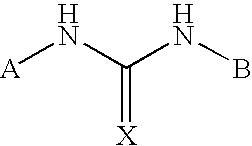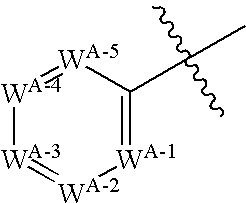Positive allosteric modulators of the nicotinic acetylcholine receptor
a technology of nicotinic acetylcholine and allosteric modulators, which is applied in the direction of drug compositions, instruments, and metabolic disorders, can solve the problems of low efficacy and safety ratio, difficult to test the target, and not all activities are desirable, so as to increase the activity of a positive allosteric modulator, inhibit the activity of acetylcholinesterase, and improve the effect of ach
- Summary
- Abstract
- Description
- Claims
- Application Information
AI Technical Summary
Benefits of technology
Problems solved by technology
Method used
Image
Examples
example 1
N-[4-ethoxy-2-(pyridin-4-ylamino)phenyl]-N′-(5-methylisoxazol-3-yl)urea
[0365]Absolute EtOH (300 mL) is cooled in an ice bath and sodium (2.1 g) is slowly added. The cooling bath is removed and the resulting mixture allowed to stir at ambient temperature for 2 hours. 2-Bromo-4-fluoro-1-nitrobenzene (6.0 g) is slowly added, and the resulting mixture allowed to stir for 15 hours. A solution of citric acid (1.0 M) is added until the pH was ˜4. Water is added, the volatiles are removed in vacuo and the residue taken up in EtOAc, washed with water, brine, dried (Na2SO4) and 2-bromo-4-ethoxy-1-nitrobenzene is crystallized from 1-chlorobutane / hexane. Yield 68%. 1H NMR (400 MHz, DMSO-d6) δ 8.04, 7.40, 7.11, 4.15, 1.33.
[0366]A mixture of 4-aminopyridine (0.37 g), 2-bromo-4-ethoxy-1-nitrobenzene (1.0 g) Pd2(bda) (0.15 g), BINAP (0.20 g), and sodium tert-butoxide (0.58 g) is purged with argon, then toluene (40 mL) is added and the resulting mixture heated to 85° C. for 1 hour and then cooled. T...
example 2
N-[4-ethoxy-2-(pyridin-3-ylamino)phenyl]-N′-(5-methylisoxazol-3-yl)urea
[0369]2-Bromo-4-ethoxy-1-nitrobenzene (1.06 g), 3-aminopyridine (0.38 g), Pd2(bda) (0.15 g), BINAP (0.20 g), and sodium tert-butoxide (0.59 g) is purged with argon, then toluene (40 mL) is added and the resulting mixture heated to 85° C. for 1 hour and then cooled. The solvent is removed in vacuo, and N-(5-ethoxy-2-nitrophenyl)pyridin-3-amine is purified using silica gel chromatography. Yield 77%. MS (CI+) for C13H13N3O3 m / z 260.1 (M+H)+.
[0370]N-(5-Ethoxy-2-nitrophenyl)pyridin-3-amine (0.79 g) is suspended in MeOH (˜200 mL) and 10% Pd / C is added (0.16 g). The mixture is reacted under 45 psi H2 for 1 hour, filtered and concentrated to give 4-ethoxy-N2-pyridin-3-ylbenzene-1,2-diamine as a solid. Yield 95%. MS (EI) m / z (rel intensity) 230 (33), 229 (M+, 99), 201 (20), 200 (70), 199 (11), 185 (17), 173 (12), 172 (46), 156 (12), 155 (28).
[0371]4-Ethoxy-N2-pyridin-3-ylbenzene-1,2-diamine (0.30 g), TEA (0.28 mL) and phe...
example 3
N-[4-ethoxy-2-(pyridin-3-ylamino)phenyl]-N′-[5-(trifluoromethyl)-1,3,4-thiadiazol-2-yl]urea
[0372]4-Ethoxy-N2-pyridin-3-ylbenzene-1,2-diamine (0.30 g), DMAP (˜10 mg), 2-isocyanato-5-(trifluoromethyl)-1,3,4-thiadiazole (0.29 g) are suspended in 1:1 THF / DMF (10 mL) and heated to 50° C. for 4 hours, then cooled ambient temperature for an additional 12 hours. The solvents are removed in vacuo and the residue purified by silica gel chromatography (7% [1:9 NH4OH / MeOH] / CH2Cl2 to 10%). Yield 77%. HRMS (ESI) calcd for C17H15N6O2SF3+H 425.1007, found 425.0991.
PUM
| Property | Measurement | Unit |
|---|---|---|
| temperature | aaaaa | aaaaa |
| wt. % | aaaaa | aaaaa |
| RA | aaaaa | aaaaa |
Abstract
Description
Claims
Application Information
 Login to View More
Login to View More - R&D
- Intellectual Property
- Life Sciences
- Materials
- Tech Scout
- Unparalleled Data Quality
- Higher Quality Content
- 60% Fewer Hallucinations
Browse by: Latest US Patents, China's latest patents, Technical Efficacy Thesaurus, Application Domain, Technology Topic, Popular Technical Reports.
© 2025 PatSnap. All rights reserved.Legal|Privacy policy|Modern Slavery Act Transparency Statement|Sitemap|About US| Contact US: help@patsnap.com



